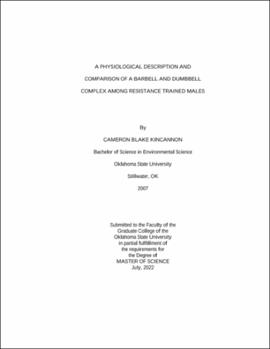| dc.description.abstract | Purpose: The purpose of this study was to provide a physiological description and comparison of a single workout complex based on different modalities (barbell and dumbbell) for male test subjects. METHODS: Ten (n=10, age (years): 24.40 ± 4.97, height (cm): 179.86 ± 5.79, weight (kg):88.06 ± 17.41, BMI (kg/m2): 27.15 ± 4.75) healthy male subjects were used for this three-week study. During week one, anthropometric measures were obtained, subjects estimated maximal aerobic capacity (VO2max) was determined during a Cooper 1.5-mile test and estimated 1 repetition maximum (1RM) values were obtained for determination of 40% 1RM of the upright row utilizing dumbbells and barbells. During week two, test subjects were fitted with a VO2 Master analyzer and heart rate monitor prior to performing either the barbell or dumbbell variation of a resistance training complex, utilizing a load of 40%1RM for the upright row. Metabolic and respiratory data including heart rate response, relative heart rate response, oxygen consumption, respiratory frequency, tidal volume, minute ventilation, ventilatory equivalents for oxygen, fraction of expired oxygen, metabolic equivalents, and energy expenditure were recorded throughout the duration of the workout. During week three, test subjects switched modalities of the workout and performed a single round of the complex workout following the same protocols from week two. Results: Significant differences in loads utilized for the barbell and dumbbell complexes were observed (p=0.002) with the barbell complex having higher values. Significant differences were also observed in time to completion between barbell and dumbbell complexes (p=0.001) with barbell complex time to completion being greater. Significant differences in energy expenditure between barbell and dumbbell complexes were also discovered (p≤0.05) with the barbell complex displaying overall greater caloric demands. | |
